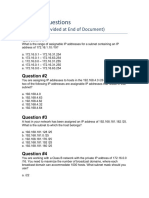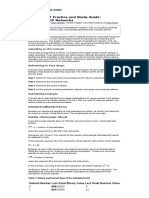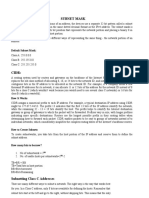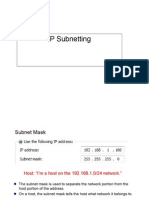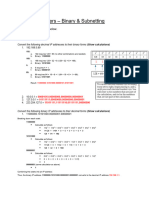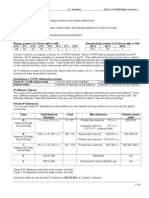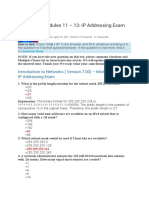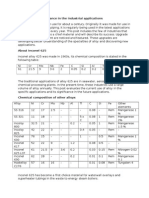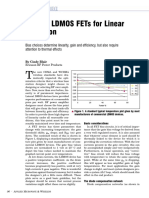The General Steps For Subnetting An Ipv4 Address: Process Is The Important Thing.)
The General Steps For Subnetting An Ipv4 Address: Process Is The Important Thing.)
Uploaded by
Colin WhelihanOriginal Description:
Original Title
Copyright
Available Formats
Share this document
Did you find this document useful?
Is this content inappropriate?
Report this DocumentCopyright:
Available Formats
The General Steps For Subnetting An Ipv4 Address: Process Is The Important Thing.)
The General Steps For Subnetting An Ipv4 Address: Process Is The Important Thing.)
Uploaded by
Colin WhelihanCopyright:
Available Formats
The General Steps for Subnetting an IPv4 Address
First of all, keep in mind the placeholder values for the eight bits of an octet: 27 128 26 64 25 32 24 16 23 8 22 4 21 2 20 1
1. From the given address, determine the address class by examining the first octet value. 2. Apply the default mask for the addresss class to determine the network portion of the address. 3. Write the network portion of the address in dotted decimal and the host portion in binary. a. Class B example: 172.16. 00000000.00000000 4. Determine the number of bits to borrow for the creation of subnets a. There are three ways this could be presented in a scenario. (For the sake of a consistent outcome, all three example options that follow will have the same result. The addresses and actual subnetting used in these examples are not the important things the process is the important thing.) 1. Option 1: The subnet mask to be applied is given in the scenario. a. Based on the given mask, determine the number of host bits borrowed to create subnets then place the subnet squiggle between the subnet bits and remaining host bits. 1. Class B example: Assume a given scenario subnet mask of 255.255.240.0. This mask indicates that four bits were borrowed from the third octet to create subnets so the subnet squiggle goes between the 4th and 5th bits in the third octet: 172.16. 0000|0000.00000000 2. Option 2: The scenario asks for the creation of a certain number of subnets. a. Apply the formula: 2N > Number of Subnets Needed (Where N is the number of host bits to be borrowed to create subnets.) Note: because of the binary placeholders, we usually have to create more subnets than are required. 1. Class B example: Assume a given scenario asking for the creation of 12 subnets so lets borrow 4 bits because 24 = 16. (Note: borrowing 3 bits gives us 23 = 8 subnets, so thats why we have to borrow 4 bits.) Lets place the subnet squiggle between the 4th and 5th bits in the third octet of our Class B address: 172.16. 0000|0000.00000000. Now determine the new subnet mask for this scenario to mask the first 4 bits of the third octet: 255.255.240.0 3. Option 3: The scenario asks for the creation of a certain number of useable host addresses per subnet. a. Apply the formula: 2H 2 > Number of Hosts per Subnet (Where H is the number of host bits remaining un-borrowed in the host portion of the 1
address.) Note: because of the binary placeholders, we usually have to create more host addresses than are required. Also, remember that the subnet and broadcast addresses cannot be assigned to a host device, therefore the reason for the minus two. 1. Class B example: Assume a given scenario asking for the creation of subnets supporting 4000 host addresses per subnet so lets leave 12 host bits un-borrowed because 212 2 = 4094. (Note: leaving 11 bits gives us 211 2 = 2046 hosts per subnet, so thats why we have to leave 12 bits.) Lets place the subnet squiggle between the 4th and 5th bits in the third octet of our Class B address: 172.16. 0000|0000.00000000. Now determine the new subnet mask for this scenario to mask the first four bits of the third octet: 255.255.240.0 5. Determine the increment between subnet addresses. a. The increment between subnet addresses is determined by the least significant bit in the subnet portion of the address (the bit just to the left of the subnet squiggle). 1. Class B example: Assume that four bits were borrowed from the third octet to create subnets, so the subnet squiggle goes between the 4th and 5th bits in the third octet: 172.16. 0000|0000.00000000. Referring to our chart of placeholder values on page one, we can see that the placeholder value of the 4th bit in the third octet is 16; therefore, the increment from one subnet to the next is 16. Always begin with subnet 0. Keep in mind that the host portion of the subnet address (the part of the address to the right of the subnet squiggle) will be all zeros in binary. Subnet Number 0 1 2 3 4 5 6 7 8 9 10 11 12 13 14 15 Subnet Address 172.16.0.0 172.16.16.0 172.16.32.0 172.16.48.0 172.16.64.0 172.16.80.0 172.16.96.0 172.16.112.0 172.16.128.0 172.16.144.0 172.16.160.0 172.16.176.0 172.16.192.0 172.16.208.0 172.16.224.0 172.16.240.0
6. Determine the broadcast address for each subnet. a. The broadcast address of each subnet will be one less than the next subnet address. Remember that the host portion of the broadcast address (the part of the address to the right of the subnet squiggle) will be all ones in binary. 1. Continuing our Class B example from Step 5-a-1 above with the addition of each subnets broadcast address: Subnet Number 0 1 2 3 4 5 6 7 8 9 10 11 12 13 14 15 Subnet Address 172.16.0.0 172.16.16.0 172.16.32.0 172.16.48.0 172.16.64.0 172.16.80.0 172.16.96.0 172.16.112.0 172.16.128.0 172.16.144.0 172.16.160.0 172.16.176.0 172.16.192.0 172.16.208.0 172.16.224.0 172.16.240.0 Broadcast Address 172.16.15.255 172.16.31.255 172.16.47.255 172.16.63.255 172.16.79.255 172.16.95.255 172.16.111.255 172.16.127.255 172.16.143.255 172.16.159.255 172.16.175.255 172.16.191.255 172.16.207.255 172.16.223.255 172.16.239.255 172.16.255.255
7. Determine the host range for each subnet. a. The host range for each subnet is simply from one more than the subnet address to one less than the broadcast address. 1. Continuing our Class B example from Step 6-a-1 above with the addition of each subnets host range: Subnet Number 0 1 2 3 4 5 6 7 8 Subnet Address 172.16.0.0 172.16.16.0 172.16.32.0 172.16.48.0 172.16.64.0 172.16.80.0 172.16.96.0 172.16.112.0 172.16.128.0 First Host Address 172.16.0.1 172.16.16.1 172.16.32.1 172.16.48.1 172.16.64.1 172.16.80.1 172.16.96.1 172.16.112.1 172.16.128.1 Last Host Address 172.16.15.254 172.16.31.254 172.16.47.254 172.16.63.254 172.16.79.254 172.16.95.254 172.16.111.254 172.16.127.254 172.16.143.254 Broadcast Address 172.16.15.255 172.16.31.255 172.16.47.255 172.16.63.255 172.16.79.255 172.16.95.255 172.16.111.255 172.16.127.255 172.16.143.255 3
9 10 11 12 13 14 15
172.16.144.0 172.16.160.0 172.16.176.0 172.16.192.0 172.16.208.0 172.16.224.0 172.16.240.0
172.16.144.1 172.16.160.1 172.16.176.1 172.16.192.1 172.16.208.1 172.16.224.1 172.16.240.1
172.16.159.254 172.16.175.254 172.16.191.254 172.16.207.254 172.16.223.254 172.16.239.254 172.16.255.254
172.16.159.255 172.16.175.255 172.16.191.255 172.16.207.255 172.16.223.255 172.16.239.255 172.16.255.255
Things to keep in mind: 1. Treat each subnetting problem individually. Do not assume that each problem will require the same solution as the one you just solved. 2. Always document (write down) the known elements from each subnetting scenario. This will help you to find the unknown elements. 3. Not every subnetting scenario will require that you determine the address of every subnet. Sometimes you may be asked to just define a single component of a subnet such as the subnet address, a host address, or the broadcast address. 4. Subnet addresses and broadcast addresses are NEVER assigned to hosts or applied to any host devices interface configuration. The only way a subnet address is used is to identify an individual subnet in your documentation. 5. It is important to document (write down) subnet addresses on diagrams. This simple documentation of subnet addresses helps you to make sure that you are applying host IP addresses in a consistent manner.
You might also like
- D&D 5E Combat Actions Cheat SheetDocument1 pageD&D 5E Combat Actions Cheat SheetSebbe100% (1)
- New Case StudyDocument20 pagesNew Case Studyanon_511099871No ratings yet
- IP AddressingDocument63 pagesIP AddressingCherry D. CasuatNo ratings yet
- Practice Questions: (Solutions Provided at End of Document)Document20 pagesPractice Questions: (Solutions Provided at End of Document)Aniket AmboreNo ratings yet
- IP Addressing and Subnetting Exercise1 SolutionDocument7 pagesIP Addressing and Subnetting Exercise1 SolutionWaqas Yasir100% (23)
- Networking - Series - 1 PDFDocument13 pagesNetworking - Series - 1 PDFsilvia emtiazNo ratings yet
- Ethos900 ManualDocument80 pagesEthos900 ManualAndres FalmacelNo ratings yet
- 9.1.4.8 Lab - Calculating IPv4 SubnetsDocument7 pages9.1.4.8 Lab - Calculating IPv4 Subnetsbreakdoen100% (3)
- Seven Steps To SubnettingDocument4 pagesSeven Steps To SubnettingIrfeeNo ratings yet
- Subnetting ProblemsDocument21 pagesSubnetting ProblemsDr. Suman RaniNo ratings yet
- Cisco CCENT Practice and Study Guide - Subnetting IP Networks - Subnetting An IPv4 NetworkDocument7 pagesCisco CCENT Practice and Study Guide - Subnetting IP Networks - Subnetting An IPv4 Networkkim pavilario0% (1)
- Subnet Mask PDFDocument5 pagesSubnet Mask PDFHamis RamadhaniNo ratings yet
- Subnetting ExamplesDocument11 pagesSubnetting ExamplesmyfanwycatNo ratings yet
- Additional Subnetting Practice MemoDocument5 pagesAdditional Subnetting Practice Memogoeda_dillon100% (1)
- Network Design CATDocument5 pagesNetwork Design CATjeffNo ratings yet
- Ch#8Document8 pagesCh#8Mohammad JuberNo ratings yet
- Lab 2.1 - Calculating IPv4 SubnetsDocument7 pagesLab 2.1 - Calculating IPv4 Subnetspzydf6wjxvNo ratings yet
- IP SubnettingDocument44 pagesIP SubnettingAli AkhtarNo ratings yet
- Calculating IPv4 Subnets - ANSWER - KEYDocument8 pagesCalculating IPv4 Subnets - ANSWER - KEYPaul John QuirosNo ratings yet
- Network Assignment 2Document15 pagesNetwork Assignment 2Philip BlegeNo ratings yet
- Binary Subnetting SolutionsDocument4 pagesBinary Subnetting SolutionsPAINGO MAIMANo ratings yet
- Unit ViDocument24 pagesUnit ViErwin VunguNo ratings yet
- Ip-Subnetting-Workbook - Part CDocument14 pagesIp-Subnetting-Workbook - Part CYazenNo ratings yet
- Welcome: Subnetting Made Easy - Critically Acclaimed!Document5 pagesWelcome: Subnetting Made Easy - Critically Acclaimed!tris8No ratings yet
- Ip AddressingDocument7 pagesIp AddressingDanial RichardsNo ratings yet
- Subnetting Made EasyDocument4 pagesSubnetting Made Easyfuhrer232842No ratings yet
- IPv4 Lab - Calculating IPv4 SubnetsDocument7 pagesIPv4 Lab - Calculating IPv4 SubnetsFlowingBurnNo ratings yet
- Q7. Soit L'adresse: CorrectionDocument7 pagesQ7. Soit L'adresse: CorrectionYacouba TouréNo ratings yet
- Class C SubnettingDocument4 pagesClass C Subnettingsmith7255No ratings yet
- Chaper 5 - SubnettingDocument62 pagesChaper 5 - SubnettingCha DechavezNo ratings yet
- NETWORKING Ass - 1 (VLSM) LEUL BAYESADocument9 pagesNETWORKING Ass - 1 (VLSM) LEUL BAYESAAbdellah TeshomeNo ratings yet
- IP AddressDocument42 pagesIP AddressAnkit RajputNo ratings yet
- Computer Networks by Bahaa Q. Al-Mussawi Subnetting Class B AddressesDocument0 pagesComputer Networks by Bahaa Q. Al-Mussawi Subnetting Class B AddressesTigabu YayaNo ratings yet
- Chapter-4 Ip Address and SubnettingDocument27 pagesChapter-4 Ip Address and SubnettingIG TECHNo ratings yet
- Exam 11-13Document21 pagesExam 11-13Tomy MoodutoNo ratings yet
- Assignment01 PDFDocument8 pagesAssignment01 PDFHamza KhalilNo ratings yet
- Assignment01 PDFDocument8 pagesAssignment01 PDFHamza KhalilNo ratings yet
- Lecture W6 CN IP Subnetting P1Document36 pagesLecture W6 CN IP Subnetting P1Hamza Ibrahim KhanNo ratings yet
- IPV4 SubnettingDocument11 pagesIPV4 SubnettingEincop Netwax LabNo ratings yet
- 2 0 SubnettingDocument16 pages2 0 SubnettingItalo Saldaña Sandoval100% (1)
- Data Communication and Networking: Subnetting by MR - Chishala GDocument24 pagesData Communication and Networking: Subnetting by MR - Chishala GMichael SiameNo ratings yet
- SubnettingPracticeExercises Revised PDFDocument20 pagesSubnettingPracticeExercises Revised PDFMartinez MachazNo ratings yet
- 8-1-4-6-lab-calculating-ipv4-subnets (1)Document7 pages8-1-4-6-lab-calculating-ipv4-subnets (1)Diostenes Norberto Arias CarmonaNo ratings yet
- IP Addressing Notes 6-2-11Document10 pagesIP Addressing Notes 6-2-11Flawless PixNo ratings yet
- How Do You Calculate The Prefix, Network, Subnet, and Host Numbers?Document6 pagesHow Do You Calculate The Prefix, Network, Subnet, and Host Numbers?mayoori75No ratings yet
- Networkx DiscxDocument4 pagesNetworkx Discxezrachupaza151No ratings yet
- Jawaban Jarkon 11-13 (B.inggris) .Document24 pagesJawaban Jarkon 11-13 (B.inggris) .Victor Carolus Patria BelareqNo ratings yet
- Subnetting: © 2001 Kevin Lillis, Klillis@sau - EduDocument7 pagesSubnetting: © 2001 Kevin Lillis, Klillis@sau - EduPriti GuptaNo ratings yet
- IP Subnet CalculationsDocument27 pagesIP Subnet Calculationsrajasekr1No ratings yet
- 2.2 Ipv4 Address Subnetting Part 1: ObjectiveDocument4 pages2.2 Ipv4 Address Subnetting Part 1: ObjectiveJohn HeilNo ratings yet
- Basic Subnetting AlgorithmDocument12 pagesBasic Subnetting AlgorithmHasib Hamidul Haque0% (1)
- Subnetting: Historic Network ClassesDocument9 pagesSubnetting: Historic Network ClassesLicio LentimoNo ratings yet
- IP Addressing: ClassesDocument6 pagesIP Addressing: ClassesQaid Saleh AledresiNo ratings yet
- CnassnDocument8 pagesCnassndeepanshuNo ratings yet
- IP Address and SubnettingDocument22 pagesIP Address and Subnettingmarkpter85No ratings yet
- Tutorial 4Document4 pagesTutorial 4s18k03z25No ratings yet
- CCNA 1 v7 Modules 11 - 13: IP Addressing Exam Answers FullDocument19 pagesCCNA 1 v7 Modules 11 - 13: IP Addressing Exam Answers FullAdha Estu RizqiNo ratings yet
- SubnetingDocument5 pagesSubnetingZigiju NebeyNo ratings yet
- Investigating Cryptocurrencies: Understanding, Extracting, and Analyzing Blockchain EvidenceFrom EverandInvestigating Cryptocurrencies: Understanding, Extracting, and Analyzing Blockchain EvidenceRating: 5 out of 5 stars5/5 (1)
- Arrilaser User ManualDocument328 pagesArrilaser User Manual程杰No ratings yet
- Brkcam 2007Document111 pagesBrkcam 2007Enrique VillaNo ratings yet
- Installation Manual: 13-5/8" 5K X 11" 10K Casing Spool AssemblyDocument9 pagesInstallation Manual: 13-5/8" 5K X 11" 10K Casing Spool Assemblyhaoues23No ratings yet
- Measurement of Radiated Ship Noise PDFDocument10 pagesMeasurement of Radiated Ship Noise PDFBùi Trường GiangNo ratings yet
- VRScript - LinkvertiseDocument28 pagesVRScript - Linkvertisexenno juega0.1No ratings yet
- Miller e Friesen (1982) - Innovation in Conservative and Entrepreneurial FirmsDocument25 pagesMiller e Friesen (1982) - Innovation in Conservative and Entrepreneurial FirmsSergio Seloti JrNo ratings yet
- Spring Web Services Reference DocumentationDocument101 pagesSpring Web Services Reference DocumentationpoutsmaNo ratings yet
- Price List For Painting Works: 2450 0000 PS 2300 03 A Mangalore Pta Plant JBF Petrochemicals LimitedDocument24 pagesPrice List For Painting Works: 2450 0000 PS 2300 03 A Mangalore Pta Plant JBF Petrochemicals LimitedSoumitra GuptaNo ratings yet
- Invoice OD113605156912911000Document1 pageInvoice OD113605156912911000Ankur VermaNo ratings yet
- Granular Equivalence (G.E.) Values For Various MaterialsDocument1 pageGranular Equivalence (G.E.) Values For Various Materialsجميل عبد الله الحماطيNo ratings yet
- Chassis: Clutch Manual Transmission Automatic Transmission Transfer Suspension System Brake SteeringDocument90 pagesChassis: Clutch Manual Transmission Automatic Transmission Transfer Suspension System Brake SteeringLuis Fernando Vasquez RamosNo ratings yet
- 1500 GPMDocument5 pages1500 GPMWissam JarmakNo ratings yet
- Chieftain 1700 Dry - RinserDocument17 pagesChieftain 1700 Dry - RinserbogdanmichaelNo ratings yet
- Ls Prepost 4 0 Manual PDFDocument3 pagesLs Prepost 4 0 Manual PDFMohamed AmineNo ratings yet
- 18 Sanket Chases, Recesses and HolesDocument10 pages18 Sanket Chases, Recesses and HolesVaibhav PatelNo ratings yet
- Layout & Lambda Design RuleDocument1 pageLayout & Lambda Design RuleNihar PandaNo ratings yet
- How To Create A FlowchartDocument3 pagesHow To Create A Flowchartasafoabe4065No ratings yet
- Inconel 625 Significance in The Industrial ApplicationsDocument7 pagesInconel 625 Significance in The Industrial Applicationsheanjiametals100% (1)
- One Shot Class 11Document64 pagesOne Shot Class 11Deepak SuyalNo ratings yet
- Modeling: Authorization in SAP NW BIDocument6 pagesModeling: Authorization in SAP NW BIKarthik EgNo ratings yet
- Renewable Energy On Small IslandsDocument135 pagesRenewable Energy On Small IslandsCognosfera100% (1)
- Deaerator MDT SeriesDocument9 pagesDeaerator MDT Seriesz3kh4No ratings yet
- Security Parameters For Unix and Linux SystemsDocument33 pagesSecurity Parameters For Unix and Linux SystemsRadu BucosNo ratings yet
- Gree Mini VRF Brochure 2020Document8 pagesGree Mini VRF Brochure 2020Hewa AkreyNo ratings yet
- Literaturereview Proposed System Cloud Security System Model Development Modules Experimental Results Advantages Conclusion ReferencesDocument17 pagesLiteraturereview Proposed System Cloud Security System Model Development Modules Experimental Results Advantages Conclusion ReferencesManoj KumarNo ratings yet
- (AMW0001) Biasing LDMOS FETs For Linear OperationDocument3 pages(AMW0001) Biasing LDMOS FETs For Linear OperationThanhha NguyenNo ratings yet
- Sepam Series 40 Protective Relays: User's ManualDocument256 pagesSepam Series 40 Protective Relays: User's ManualccrrzzNo ratings yet




